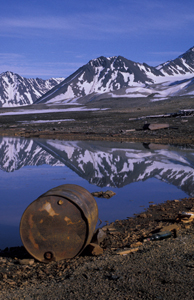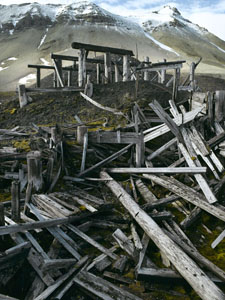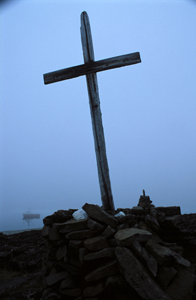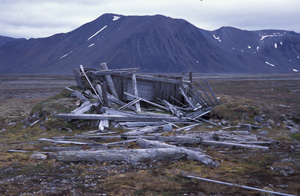 (Image: Kolbein Dahle / The Governor of Svalbard)
(Image: Kolbein Dahle / The Governor of Svalbard)
 (Image: Guri Dahl / Svalbard museum)
(Image: Guri Dahl / Svalbard museum)
 Humans influence landscapes, and natural environments provide the conditions for human exploitation and activities. (Image: Kristin Prestvold / The Governor of Svalbard)
Humans influence landscapes, and natural environments provide the conditions for human exploitation and activities. (Image: Kristin Prestvold / The Governor of Svalbard)
 Ruins of an old hunter’s and trapper’s cabin at the island of Prins Karls Forland. Natural forces are taking back the land. (Image: Kristin Prestvold / The Governor of Svalbard)
Ruins of an old hunter’s and trapper’s cabin at the island of Prins Karls Forland. Natural forces are taking back the land. (Image: Kristin Prestvold / The Governor of Svalbard)
 The remains of the mining operations in Tunheim, on Bjørnøya (Bear Island), from the start of the 20th century, like this locomotive, were abandoned when people gave up the operations and moved. (Image: Kristin Prestvold / The Governor of Svalbard)
The remains of the mining operations in Tunheim, on Bjørnøya (Bear Island), from the start of the 20th century, like this locomotive, were abandoned when people gave up the operations and moved. (Image: Kristin Prestvold / The Governor of Svalbard)
Svalbard is regarded one of Europe’s last areas of untouched wilderness. With a harsh, exotic and extreme environment, the archipelago seems almost unaffected by humans. Still, 400 years of human presence have left traces in Svalbard. The remains of people’s living act as story-telling fragments from the past. They are traces of activities that have taken place under conditions balancing at the very edge of human capabilities.
Cultural remains are the traces humans have always left behind in the landscape, and are still leaving behind. They include every single piece of rusty nail or cartridge case in an old hunting and trapping station that is falling to pieces, and the grand machines and technical equipment that stand out starkly against the surrounding natural environment and wilderness. Cultural remains in Svalbard show the tight coupling between human activities and the natural environment, and give an impression of how humans have influenced the natural environment through exploitation of resources throughout history. At the same time they show how the natural environment has affected human activities.
Cultural remains are found in coastal areas all around the archipelago. The same set of criteria have always been decisive when people have decided where to establish their activities and homes. The important elements have been closeness to the biological or mineral resources for exploitation, easy access and landings, a good harbour that gives protection against stormy weather, nearness to beaches with driftwood and easy access to freshwater supply. Throughout Svalbard’s history, people have come to places that have met these criteria. As a result, cultural remains from various time periods are often mixed and gathered in the same locations. The remains of a Russian hunting and trapping station from the 18th century might well be located next to an older whaling station from the 17th century. Graves from the Russian overwintering trapping are sometimes placed inside the tryworks from the whaling time. Yet another trapper’s cabin from Norwegian trapping in the 20th century might be located in the same area. In some places remains of a Russian trapping station can have been changed, extended and used in later trapping periods.
Traces of humans in Svalbard are diverse. They can be hardly visible tracks at exposed locations in the Arctic wilderness, or they can be remains of activities well protected by layers of soil and vegetation. Some places we find buildings still in use, and other places robust constructions from heavy industry left in the landscape. Activities in Svalbard have always been diverse, and this is mirrored in the cultural remains conserved there.
Cultural remains in Svalbard are often exposed to natural and human induced detrimental processes different from lower latitudes. Common processes of degradation are first of all river and beach erosion, plus mass flow (or debris slides) and deposition of sediments along streams. The constantly shifting river courses in the flat valleys also erase fragile cultural traces. Heavy movement of the soil as a result of permafrost, rot due to humidity, and general wear and tear from winds also negatively affect the remains. Human induced processes catalyse the natural decay, for example, wear and tear from traffic and treading directly on the cultural remains or the surrounding vegetation.
Some of the traces of humans who lived in previous times are easy to interpret and understand, but some need explanation. Many cultural remains are hard to catch sight of, and some may cause astonishment. Yet others can arouse irritation and anger and be difficult to perceive as worthy of preservation. However, these physical traces are the frames of previously lived lives. Take an old hunter’s and trapper’s cabin falling to pieces as an example. It looks more like a collection of drift wood and logs, as it is slowly brought to ruins in the course of nature and time. Still, it is possible to see how the cabin was erected, with its framework comprised of load-bearing corner uprights and walls built of vertical boards and pieces of wooden boxes. Outside the cabin lie pieces of broken glass from damaged windows and nails that once kept the walls together and the roof in place. In a corner inside the cabin stands a rusty furnace, a handle-less mug lies on the floor and broken plates are spread out under the table. Another example could be a tryworks, used to render blubber during whaling times, visible in the landscape as an overgrown rise in the ground on the beach just above the high tide mark, which would be hard to interpret as a tryworks just by looking at it. Traces in the landscape are often illegible without proper knowledge. Cultural remains can therefore be exposed to human intervention, usually from ignorance. Some people make fires in the old tryworks, camp on top of old homesteads, or take chest boards for firewood. Knowledge of the cultural remains and the history behind them can make the cultural remains appear differently and stand out as more important.
Behind the cultural remains lie the stories of living women and men who persued their activities in Svalbard. They were people who challenged and defied the constraints of existence and strived to gain a livelihood despite the challenges they met. In the context of the Arctic landscape, the cultural remains add a human dimension to the surroundings – once surrounded by hustle and bustle; today silent testimonies of people and their destinies. Everything is tightly coupled and forms floating and story-telling wholes. The whole is reduced if anything is lost.
All the cultural remains have their own story to tell, from the broad lines representing changing traditions from the past to today, to the isolated individual stories. They are story-telling traces of people in the past and important elements in the experience and communication of landscapes and history. We are facing a limited resource that has great information value and adds much to the experience of Svalbard. Every single remain is unique and cannot be replaced. The large structures in the landscape, such as the network of trappers’ cabins in a trapping area and the remains of mineral extraction facilities, draw the big lines. They tell the stories of operations, production and the extent of the activities. Smaller structures reveal the details of the activities. These include small wagons on twisted rails, tractors, tractor wagons and drilling equipment. It could be the remains of buildings like a forge, workshop, workmen’s hut and mess, and also collapsed board booths with drilling equipment, bellows and parts of steam engines. Between the larger and smaller structures lie the small details. They tell stories of people’s lives at the site, about their duties and functions. The remains of traps, bones, clay pipes, tools, cartridge cases, broken pieces of pottery and glass, shoe soles, rusty nails and tin cans tell the isolated stories belonging to individual and unique occurrences. Story-telling fragments of the past.
The cultural remains from the first decades of the 20th century are often linked to industrial activities in Svalbard. Most of the industrial projects ended shortly after start-up, and the traces that are left in the landscape bear witness to dearly bought experience. To start trial operations and mineral exploitation in this early period were a gamble, with the operations being sensitive to oscillations in the world market. Large investment costs were associated with start-up, and the transport of all the equipment and crew to Svalbard was time-consuming and demanding. Moreover, the work seasons were short and hectic. Trial operations were often shut down after just a few years. The dream of quick money burst, the expectations of tidy profit were ruined. The value of the plants was often less than the costs of disassembly and transport back to the mainland. In most cases plants and equipment were therefore left in place, often unused. In many places in Svalbard, the remains of the industrial activities are left behind as well preserved evidence of local operations. Much of the technical equipment, installations and machinery are unique to Svalbard, and there is hardly anything like it anywhere else.
Slowly but surely the remains of past lives and activities decay. The traces of people before us are erased and in the end disappear. Nature takes its land back. These are natural processes that are hard to change even if this were desirable. We borrow the traces of past realities for a short time. Unfortunately, the cultural remains are also exposed to human induced detrimental processes. They are vulnerable to footsteps, other forms of traffic and souvenir collection. It is important that we don’t contribute to increase the natural decaying processes. Through our behaviour we should contribute to making the cultural remains a continuous source of exploration and knowledge. In that way, coming generations can gain the same great experiences at the frontier between the past and present time.
All traces of human activities from 1945 or earlier are protected cultural remains in Svalbard. This means that all types of constructions, like buildings and remnants of houses, trapping devices and installations, from the whaling times up to and including World War II are protected and must not be destroyed, removed or marred. The same restrictions apply to all single objects that are spread around along the coasts of Svalbard. They may seem like refuse and rubbish, lumber and mess, like foreign elements in an otherwise untouched wilderness. More than the large constructions, the single objects tell unique stories of people’s everyday lives and tasks at the site. They are not to be picked up or removed. Bringing protected objects out of Svalbard is prohibited by law.
Graves are the most common cultural heritage sites in Svalbard. The graves must not be touched, and must be treated with respect. All graves, crosses and bones are protected independent of their age. This also applies to remains of skeletons at the slaughtering sites for whales, walruses and polar bears. The unique hunting device, the self-firing gun trap for polar bears, is also protected by law.
This legal protection extends across a protective zone of 100 metres around all fixed protected structures from human activities in the landscape. The slaughter sites are also counted as fixed cultural remains. Within the protective zone camping and bonfires are prohibited, as is leaving any other traces of your visit.